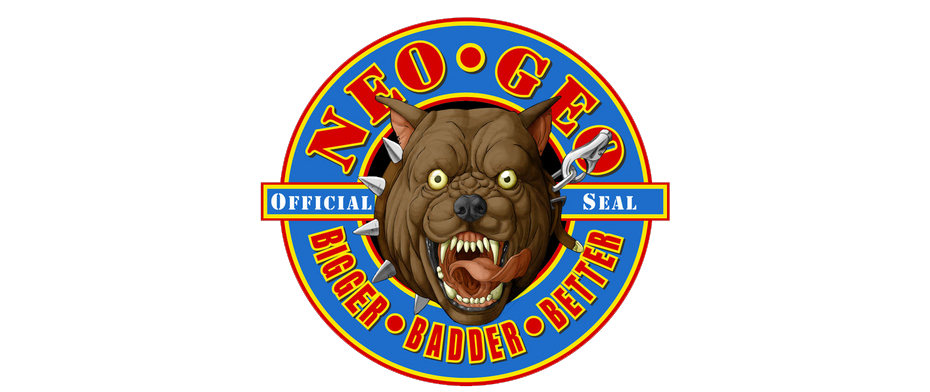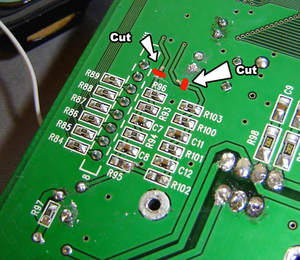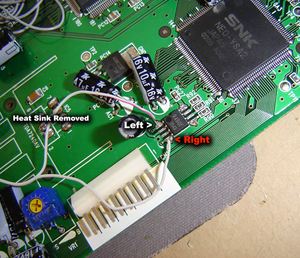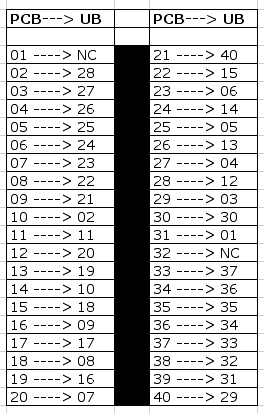Difference between revisions of "How to Consolize an MVS Board"
XianXi-12537 (talk | contribs) m |
XianXi-12537 (talk | contribs) m |
||
| Line 215: | Line 215: | ||
|} | |} | ||
<!-- END OF TABLE --> | <!-- END OF TABLE --> | ||
| + | |||
| + | |||
| + | == Adding a Unibios == | ||
| + | |||
| + | A Unibios is an essential tool for your CMVS. One of the great things about it is that it lets you turn your CMVS into an AES with the console mode option. | ||
| + | |||
| + | On an MV1C the Bios is a surface mount chip like the MV-1B, unlike the other boards with a socketed bios you will need to wire up a socket to add a Unibios. | ||
| + | |||
| + | First thing you should know is that both chips have 40 pins BUT are not pin for pin as far as output. You will need to follow the pinout from the Unibios chip to the MV-1C bios. | ||
| + | |||
| + | For this you will need: | ||
| + | |||
| + | * (1) 40 pin 1024 socket | ||
| + | * 28-30 awg wiring | ||
| + | * Solder | ||
| + | * Soldering Iron | ||
| + | * Breadboard | ||
| + | |||
| + | Mount the socket to the breadboard and solder it. From here you can either solder the 40 wires to the socket first or to the board. | ||
| + | Some people use ribbon cable which is easier to use. Follow the pinout below to solder the pins correctly. | ||
| + | |||
| + | [[Image:Ub.png]] | ||
| + | |||
| + | |||
| + | |||
| + | *If After you connect the Unibios and it doesn't boot, you may need to bridge pins 39 and 40. I've only had to do this on 1 board. | ||
| Line 224: | Line 250: | ||
*Vibration Feedback - If you figure this out, email me. | *Vibration Feedback - If you figure this out, email me. | ||
*RGB Pots - Doesn't really make much sense unless your TV is super bright or something but if that's the case just change the resistor value on your encoder. | *RGB Pots - Doesn't really make much sense unless your TV is super bright or something but if that's the case just change the resistor value on your encoder. | ||
| + | |||
''Page by Xian Xi'' | ''Page by Xian Xi'' | ||
Revision as of 08:36, 29 September 2008

In This Guide
In this guide I will show you how to consolize an MV-1C MVS board. What is consolization you ask?
Consolization is basically turning an arcade board which is made to be played in an arcade cab playable on a regular TV with control pads just like any other home console, hence the term "Consolization". The difference between a CMVS and a supergun is that a CMVS is a "dedicated" supergun that only plays MVS games.
This is where you ask yourself "Do I want to make a CMVS or a supergun?". You decide.
Parts Needed
- Wiring (I use 22 awg usually)
- Solder (I prefer leaded 2% silver)
- Soldering Gun
- Audio, Video and Power Jacks (I use color coded Gold Panel Mounts)
- RGB > NTSC Video Encoder (I prefer the Neobitz)
- +5v Power Supply, I prefer this one from Jameco.
- Power Switch (Rocker style or anything that can handle at least 2 amps. Do NOT use momentary push buttons for power.)
- Dremel or Xacto Knife for cutting
- DB15 Controller Ports
- Ice Cold Beer (After Completion)
Enclosures
For enclosures it is all up to you, you can either do an "Open Face" CMVS which is a bare board with no fancy enclosure or a fully cased CMVS. Keep in mind that putting an MVS board into a case can be difficult and also may take you a while to find an enclosure you like.
Several companies make plastic, wood and metal enclosures. Hammond Manufacturing makes both plastic and metal ones. Other companies like PacTec only make plastic ones. Some CMVS builder have used Plexiglass, old PC cases and even NGH and NeoCD cases. Making an "Open Face" CMVS takes about 3-5 days to complete depending on cleanliness. An enclosed CMVS can take up to 3 weeks depending on difficulty with the casing material. However an "Open Face" 2 slot will only take you about 8 hours or less total build time, this is due to having everything you need already on the board and all you need is a PSU and RGB > NTSC Encoder.
Stereo Sound Mod
The MV-1C board does not give Stereo Sound off the jamma edge so you will need to do a simple hack to achieve Stereo Sound.
First, you need to remove the heat sink on the board. That is the big silver thing on the bottom right corner of the board. You can remove it by either desoldering it or just clipping the legs. I don't ever plan on re-using them so I just cut the legs and then desolder the 2 posts holding it to the board.
For stereo sound on an MV-1FZ go here.
Click on the images for a larger view
In Figure 1-1 you will need to cut the 2 traces indicated. You can use an Xacto knife to cut them but I prefer to use a dremel to kind of carve it out a little to ensure that the traces are no more.
In Figure 1-2 is the onboard sound chip on the MV-1C. Gently bend back the surrounding capacitors to get to Pins 1 & 4. Solder a wire to each pin. Pin 1 is audio Left Pin 4 is audio Right
Powering the Board
Powering the board is simple, you just provide +5v and ground. With the PSU I recommended all you need is a panel mount 2.1mm barrel jack which can also be purchased a Jameco. The barrel jack has 3 pins but you will only be using 2 of them. Remember that the PSU has positive tip polarity which means that the center pin will carry the +5v supply, the edge will be the ground. I always use a multimeter as a habit when doing it just to ensure everything is correct. Just mount the barrel jack and plug in the psu without wiring it to the board and use your tester to check which pin is which. Just remember that when powering your board with only +5v the sound will not come off the jamma edge as that is where the amplified sound is tapped to. You will need to find the source before it hits the amplifier, for an MV-1C this mod is shown below.
Once you confirm which pin is the +5v go ahead and connect it to a power switch, you can use a rocker switch for this or whatever you choose. From there connect the power to Jamma PINs 3,4,C,D. And the ground to Jamma PINs 1,2,A,B.
The Video Encoder
For the Video Encoder I always use the Neobitz as it's the best for the Neo. The JROK is exceptional as well. This is just personal preference. Here you can choose which video outputs you would like.
- Composite - Most commonly known as the "Yellow" on those Red, White and Yellow A/V Cords. Composite uses 1 wire to transfer video data.
- S-Video - AKA S-VHS, provides better video quality than the composite. S-Video uses 2 wires to transfer video data.
- Component - AKA Color Difference AKA RGB by n00bs. Just to clear things up, Component is not RGB it is a different system.
- Straight RGB - If you have a TV that can take straight RGB then you dont need an encoder but you will need to wire up a custom adapter to transfer the signal to your TV.
Depending on what outputs you want the price of course changes. Composite and S-video go hand-in-hand as both signals come off the same chip. There is usually about a $30-50 difference between an encoder that outputs Composite with S-video and an encoder that outputs all three.
Usually the JROKs and Neobitz boards come with the Panel Mount jacks that you need, they come with the basic ones but for a little more money you can upgrade to gold jacks which offer better connectivity as well as endurance against the elements.
Connecting the Video Encoder
The Video Encoder uses these signals: Red, Green, Blue, Sync, Video Ground and +5v.
These signals are pulled from the MVS board at these corresponding pins:
- Red - 12
- Green - N
- Blue - 13
- Sync - P
- Video Ground - 14
- +5v - From Power Supply
Connect the above pins to the input on the video encoder. Take the wires from the output of the encoder and connect those to your Video jacks. Remember to connect the center pin on the jacks to the output of the video encoder. The video ground from the encoder connects to the outside of the jacks.
- When testing your video using component, on some TVs you may notice that the picture doesn't display properly or is scrambled. This is due to the The Neo's horizontal sync which is around 59.18 Hz. NTSC spec is 59.94 Hz (not 60!) that makes it only 1.3% off, which is easily within an analog TV's much less an HDTV's tolerance. According to SNKNostalgia a simple 0.01uf Ceramic Cap on the sync line sometimes remedies this problem.
Adding Controller Ports
Above is a picture of a DB15 controller port viewed from the front side, the solder side will be opposite. Now for these projects you do not "have to" use these ports since you are making it your own. But if you would like to use your existing Neo Geo controllers you should use them unless you will also build a small converter that has a DB15 connector to convert to your custom pinout if you choose.
Even though there are 2 pins that are used for the D button, only Pin 4 is used for 99% of the games. Pin 9 is used basically for the rare mahjong controller.
Keep in mind that if you do not plan on using a Unibios you must wire up the coin buttons (Pin 16, T)to the select buttons (Pin 3) on the Neo controller. If you use a Unibios it makes the select button act as a coin button. If you do not want to wire it up to the controller you can add buttons on your CMVS for coins, I personally think that's retarded.
The standard Neo Geo Controller pinout:
| PIN # | Description | JAMMA PIN # P1 | JAMMA PIN # P2 |
|---|---|---|---|
| 1 | Common (Ground) | 1,2,27,28,A,B,e,f | Same |
| 2 | NC - No Connection | NC | NC |
| 3 | Select | 26 | d |
| 4 | D Button | 25 | c |
| 5 | B Button | 23 | a |
| 6 | Right | 21 | Y |
| 7 | Down | 19 | W |
| 8 | VCC +5v | 3,4,C,D | Same |
| 9 | D Button | 25 | c |
| 10 | NC | NC | NC |
| 11 | Start | 17 | U |
| 12 | C Button | 24 | b |
| 13 | A Button | 22 | Z |
| 14 | Left | 20 | X |
| 15 | Up | 18 | V |
Adding a Unibios
A Unibios is an essential tool for your CMVS. One of the great things about it is that it lets you turn your CMVS into an AES with the console mode option.
On an MV1C the Bios is a surface mount chip like the MV-1B, unlike the other boards with a socketed bios you will need to wire up a socket to add a Unibios.
First thing you should know is that both chips have 40 pins BUT are not pin for pin as far as output. You will need to follow the pinout from the Unibios chip to the MV-1C bios.
For this you will need:
- (1) 40 pin 1024 socket
- 28-30 awg wiring
- Solder
- Soldering Iron
- Breadboard
Mount the socket to the breadboard and solder it. From here you can either solder the 40 wires to the socket first or to the board. Some people use ribbon cable which is easier to use. Follow the pinout below to solder the pins correctly.
*If After you connect the Unibios and it doesn't boot, you may need to bridge pins 39 and 40. I've only had to do this on 1 board.
Extras??
- Test Button - If board is enclosed it helps to have one on the enclosure BUT if you have a Unibios you do not need one. You can access the test menu via the Unibios.
- Service Button - For what? A service button was used by operators to add credits without them being added to the revenue count in the banking feature. Other systems need the service button for navigate the test menus but the Neo doesn't.
- Headphone Jack - It's up to you but you need to rig up something that turns it on and off so it doesn't create impedance issues with the RCA outs.
- Vibration Feedback - If you figure this out, email me.
- RGB Pots - Doesn't really make much sense unless your TV is super bright or something but if that's the case just change the resistor value on your encoder.
Page by Xian Xi



